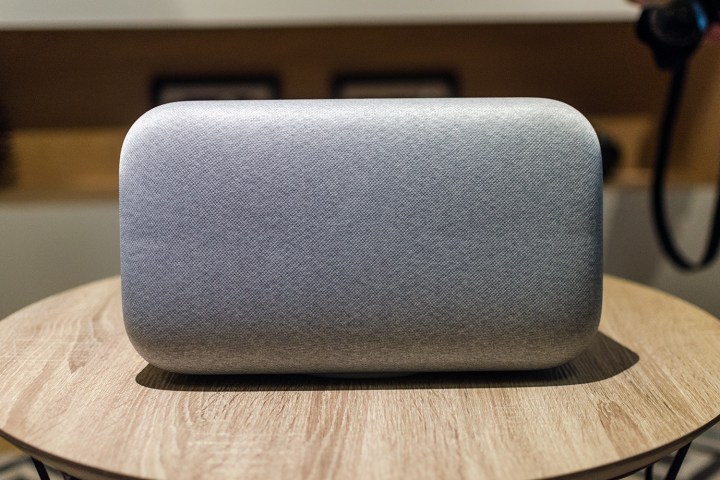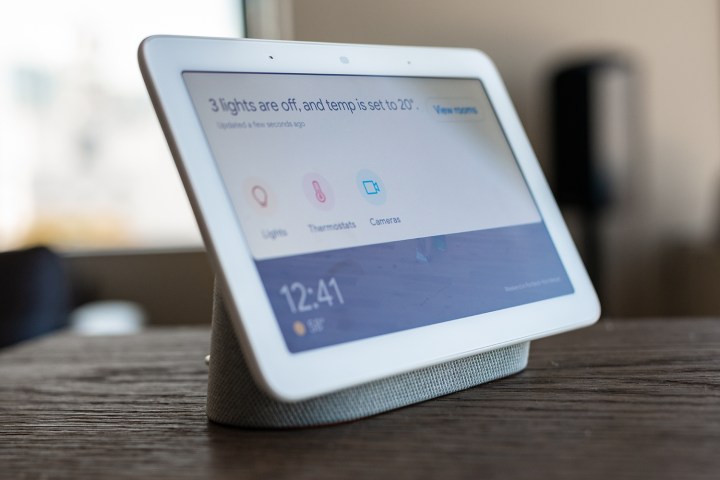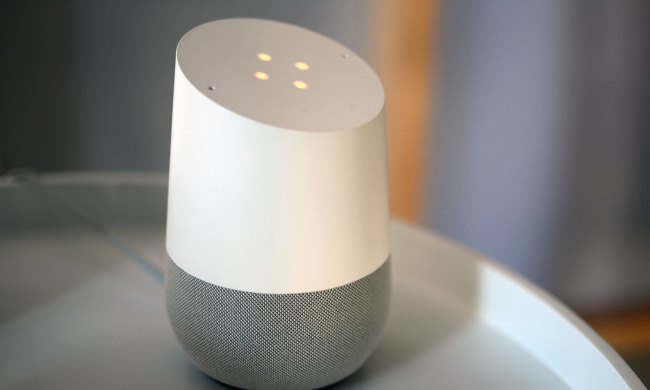Google has made a permanent mark in the world of smart speakers and displays. With options including the Google Nest Audio, Google Nest Mini, Google Home, Google Home Mini, Google Home Max, Google Nest Hub, and Google Nest Hub Max, there’s a device to serve every need, whether you need a control hub for your home’s smart ecosystem, or you’re just looking for a quality speaker to blast your tunes from.
Each of these products features the Google Assistant voice assistant and allows you to make phone calls, so what it really comes down to is sound and whether you prefer a screen. Here’s what you need to know when deciding which Google device is for you.
Rectangle, puck, or …?
Google devices come in a variety of shapes and sizes. Here are the stats:
- The Nest Audio speaker is 7 inches tall, 5 inches wide, and stands as tall as a small humidifier.
- The Nest Mini is 2 inches tall, 4 inches wide, and is about the size of a hockey puck.
- At 3.86 inches in diameter and 1.65 inches high, the Google Home Mini is about the size of a doughnut.
- The original Home is 3.79 inches in diameter and 5.62 inches tall.
- The Google Nest Hub is rectangular, a little over 4.5 inches tall, and it has a 7-inch touchscreen display.
- Nest Hub Max comes in at 9.85 inches by 7.19 inches and has a 10-inch screen.
- The Home Max measures in at 13.2 inches by 7.4 inches by 6.0 inches.

Concerned about color? The Google Nest Audio comes in charcoal, chalk, sand, sage, and sky. The Nest Mini is available in black, light gray, coral, and light blue. The top of the Google Home speaker is white, but it has a swappable base that comes in a variety of colors: Copper and carbon for the metal version and coral for the fabric. The Mini and Max are partly white with the fabric covering available in a light gray (chalk) or carbon (darker gray). The Mini also comes in coral and aqua. The Nest Hub Max comes in chalk and charcoal.
All the speakers have touch control. You can turn the microphone off via a switch, so they can’t eavesdrop on your conversation. You can also play or pause music, change the volume, or activate Assistant. LED lights show up when the devices are listening or thinking.
The Hubs have a pull-down screen that gives you access to and control over your smart home devices. On the Hub, you can watch video tutorials, while a Nest Audio, Nest Mini, Home, Home Mini, or Home Max will read you the instructions.

Assistant assistance
All of the Google Nest and Home devices have the same Google Assistant inside, so there’s no reason to opt for one over the other in that aspect. It’s great at answering trivia-like questions, like, “Who won the World Series in 1976?” Theoretically, the Assistant is supposed to be conversational and answer follow-up questions, but when we asked, “Who won the next year?” she replied that she couldn’t help with that yet. (For the record, browser Google says it’s the Cincinnati Reds, followed by the New York Yankees in 1977.) Sometimes it will just read the top Google result, and that’s not always helpful when the answer is nuanced, like when you want to know where the hottest place on Earth is.
In addition to answering questions, the Assistant can also tell you the weather or your schedule, give traffic information, and control smart-home devices. Since its debut, Google Nest and Home products have become more useful in the last category, gaining the ability to control more than 1,000 smart-home devices. It obviously works with Nest, another Alphabet company, as well as Philips Hue smart lights, August smart locks, and so on.
If you give it permission, Google Nest and Home devices can also recognize your voice via what the company calls Voice Match, so it will call your contacts instead of your significant other’s. Handy if you both have a contact called “Mom.”
You will also be able to take advantage of skills or tasks that let you make the most of Assistant. From the Google Home app, tap the menu button and hit Explore, and you will see offerings from the Food Network, Netflix, Sports Facts, and more. You don’t need to enable these skills to use them, but for something like Uber, you have to link your account.
Google also engineers Nest and Home gear to capture kids’ imaginations with content from Disney, classic and original stories, and games like musical chairs. You will also be able to use Family Link to create accounts for children and tweens. It can help you set parental controls and monitor what the kiddos are up to like a conscientious big brother.
The Hubs can do everything the dedicated speakers can do, but they can also show you results on the screen. In addition, you can display your pictures, watch YouTube, stream movies and TV, control your smart home with touchscreen controls, and see who’s at your front door if you have a video doorbell. If you’re looking to get the most out of Google Assistant, you’ll probably want to go with a Hub.

The tunes
Google Nest and Home devices work with Spotify, Google Play Music, Pandora, and iHeart Radio. In addition to streaming music, you can also listen to podcasts. Though the Mini speakers sound decent for their size and their 40-millimeter driver produces 360-degree sound, they also can wirelessly connect to any speaker with Chromecast built-in. You can use it independently, but your music won’t sound the same as it does coming out of a typical Bluetooth speaker, for example.
The Google Nest Audio delivers impeccable sound, with well-balanced highs, mids, and lows. With the 75mm mid-woofer, bass is particularly strong on the latest Google speaker. With onboard Media EQ and Ambient IQ audio features, the Nest will adapt its sound to both the music you’re listening to and the environment the speaker is placed in. If you want to crank the treble or want even more bass, EQ options in the Google Home app allow you to make final adjustments to your Nest sound.
For the original Google Home, DT’s Senior Editor Caleb Denison said it sounds like the Amazon Echo Tap as opposed to the full-size Echo speaker. Google’s Home over-juices the bass, he said, and it sounds compressed and a bit dirty when you turn it up too loud. Still, he thinks it gets the job done if you just want to sing along to something while doing the dishes.
The Google Nest Hub has two far-field microphones and a full-range speaker, and multi-room audio capabilities. It sounds decent, but if music is your number one concern, you’ll probably want to go with one of the Max versions.
To deliver the biggest and loudest device they could, Google went all out with its Home Max, where the sound is the real selling point. Google wants you to buy it instead of the Sonos Play:5 or the Apple HomePod, which is supposed to have room-reading tech similar to Sonos. The Home Max has 4.5-inch high-excursion drivers, so it does bass and loud volume better than the Nest Audio and Home. Two tweeters cover the high frequencies, and the speaker is controlled by advanced digital signal processing (DSP). Using Smart Sound, the speaker analyzes the environment and adjusts the sound curve to match the room. Based on thousands of room presets, the speaker will calibrate to a room with carpeted floors and plush pillows differently than one with hardwood floors and office furniture. Smart Sound will also take into account things like the time of day and what you are listening to. Music will be softer in the mornings, for example.

How much will you pay?
You can expect to pay around $99 for the Google Nest Audio, with its miniature offering, the Nest Mini, retailing at $49. The classic Google Home (if you can still manage to find a new version) sells for $99. The Google Home Mini comes with a price tag of $49, the Home Max will cost you $299, the Nest Hub Max costs $229, and the Google Nest Hub comes in at $129. However, given the right circumstances and depending on where you look, you can frequently snag some bargains on each of the Home devices.
Which one is right for you?
Google would probably prefer for you to purchase all of its speakers and scatter them throughout your house. As a matter of fact, you can assign speakers to specific rooms, making it a tad simpler for you to control multiple devices at once. But which one (or ones) you get is clearly determined by your budget and placement preferences. The Nest Mini appears like an excellent option for a child’s room, while you might want the original Nest Audio’s fuller sound for the living area and the musically inclined Home Max for a game room or basement. The Nest Hub is also excellent when used in central locations in the home, like your kitchen or living room.
In any case, you can also decide whether you want your Assistant to respond to you in a female or male voice, which is a pleasant change from the norm. You can read our complete review of the Google Nest Hub Max here, Google Nest Audio here, Google Nest Mini here, Google Home here, Google Home Mini here, Google Home Max here, and Google Nest Hub here to check out our thorough examination of each of these devices.



